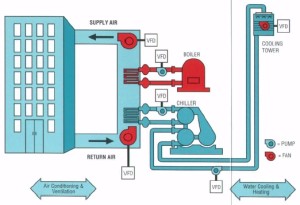 Heating when it’s cold, cooling when it’s hot. That’s as simple as you can put it. These are simple demands that are routinely met any time someone reaches for the thermostat for a little adjustment to the environment. But sometimes, and usually at the worst time, your air conditioner won’t run or your heater stops heating. Let’s see about solving some of those problems and delving into different systems to see how they work to better understand how to keep these problems from occurring.
Heating when it’s cold, cooling when it’s hot. That’s as simple as you can put it. These are simple demands that are routinely met any time someone reaches for the thermostat for a little adjustment to the environment. But sometimes, and usually at the worst time, your air conditioner won’t run or your heater stops heating. Let’s see about solving some of those problems and delving into different systems to see how they work to better understand how to keep these problems from occurring.
Forced air HVAC systems are the most common type in residential homes.The most basic of basics is that your HVAC system is designed to draw air in from the intake valve, heat the air, and then push it through the ductwork and out the vents. If you are seeing dust bunnies hopping from the vents change your filter and vacuum the intake valve to stop them. If they are still coming out, you need to have your ducts cleaned.
Your forced air system will be either gas or electric. If you have gas you’ll need to have a pilot light continuously lit. The flame should appear blue. If you cannot see the pilot light, then nothing is heating the air to blow through your vents. With electric, if you have it running to the house, your heat and air should run. If it’s not, check the breaker.
Every heat pump has an outdoor condenser unit and an indoor evaporator coil unit. Heat is carried from one to the other. When this liquid is compressed, it is a high temperature, high-pressure liquid. If it is allowed to expand, it turns into a low temperature, low pressure gas. The gas then absorbs heat. Heat pumps extract heat from the outdoor air and deliver it inside during the winter. Cold air contains a great deal of heat, even though this sounds backward. They do just the opposite in the winter. There is still a fan, like in a forced-air system, that blows the warmed or cooled air into the ducts.
Geothermal heat pumps perform the same functions as a regular pump but they use the earth’s natural temperature to cool and warm rather than gas or electricity. Tubing is run in the ground and this same coolant is heated by the earth’s temperature then delivered to the house. This process is more environmentally sound as it uses less energy and no fossil fuels.
These are just a few of the basic principles guiding the systems that heat and cool most homes. Mckinnon Heating and Cooling deals with all these system types and more. Call us today if you’re having trouble with your HVAC system or if you’re looking upgrade.
